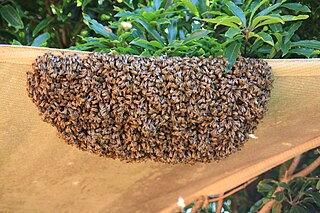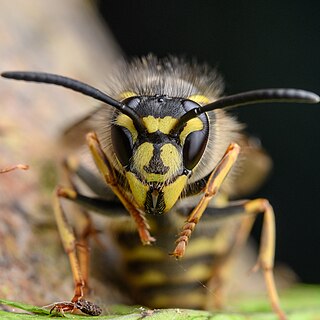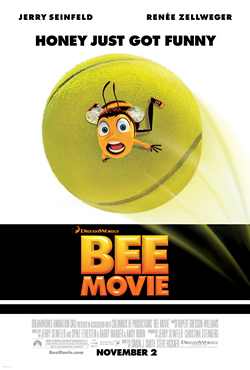
Bees are winged insects closely related to wasps and ants, known for their roles in pollination and, in the case of the best-known bee species, the western honey bee, for producing honey. Bees are a monophyletic lineage within the superfamily Apoidea. They are currently considered a clade, called Anthophila. There are over 20,000 known species of bees in seven recognized biological families. Some species – including honey bees, bumblebees, and stingless bees – live socially in colonies while most species (>90%) – including mason bees, carpenter bees, leafcutter bees, and sweat bees – are solitary.

Erik Weisz, known as Harry Houdini, was a Hungarian-American escape artist, illusionist, and stunt performer, noted for his escape acts.

Megachilidae is a cosmopolitan family of mostly solitary bees. Characteristic traits of this family are the restriction of their pollen-carrying structure to the ventral surface of the abdomen, and their typically elongated labrum. Megachilid genera are most commonly known as mason bees and leafcutter bees, reflecting the materials from which they build their nest cells ; a few collect plant or animal hairs and fibers, and are called carder bees, while others use plant resins in nest construction and are correspondingly called resin bees. All species feed on nectar and pollen, but a few are kleptoparasites, feeding on pollen collected by other megachilid bees. Parasitic species do not possess scopae. The motion of Megachilidae in the reproductive structures of flowers is energetic and swimming-like; this agitation releases large amounts of pollen.

The Asian giant hornet or northern giant hornet, including the color form referred to as the Japanese giant hornet, is the world's largest hornet. It is native to temperate and tropical East Asia, South Asia, Mainland Southeast Asia, and parts of the Russian Far East. It was also found in the Pacific Northwest of North America in late 2019 with a few more additional sightings in 2020, and nests found in 2021, prompting concern that it could become an invasive species. However, by the end of the season in November 2022, there were no confirmed sightings in North America at all, suggesting they may have been eradicated in that region.

Swarming is a honey bee colony's natural means of reproduction. In the process of swarming, a single colony splits into two or more distinct colonies.

Mason bee is a name now commonly used for species of bees in the genus Osmia, of the family Megachilidae. Mason bees are named for their habit of using mud or other "masonry" products in constructing their nests, which are made in naturally occurring gaps such as between cracks in stones or other small dark cavities. When available, some species preferentially use hollow stems or holes in wood made by wood-boring insects.

The Conopidae, also known as the thick-headed flies, are a family of flies within the Brachycera suborder of Diptera, and the sole member of the superfamily Conopoidea. Flies of the family Conopidae are distributed worldwide in all the biogeographic realms except for the poles and many of the Pacific islands. About 800 species in 47 genera are described worldwide, about 70 of which are found in North America. The majority of conopids are black and yellow, or black and white, and often strikingly resemble wasps, bees, or flies of the family Syrphidae, themselves notable bee mimics. A conopid is most frequently found at flowers, feeding on nectar with its proboscis, which is often long.

Vespula vulgaris, known as the common wasp, is a species found in regions that include the United Kingdom, Ireland, Germany, India, China, New Zealand and Australia. It is sometimes known in English as the European wasp, but the same name is used for the species Vespula germanica or German wasp. In 2010, the ostensible Vespula vulgaris wasps in North America were found to be a different species, Vespula alascensis.

Bee Movie is a 2007 American animated comedy film produced by DreamWorks Animation and Columbus 81 Productions, and distributed by Paramount Pictures. Directed by Simon J. Smith and Steve Hickner from a screenplay by the writing team of Jerry Seinfeld, Spike Feresten, Barry Marder and Andy Robin, it stars the voices of Seinfeld, Renée Zellweger, Matthew Broderick, John Goodman, Patrick Warburton, and Chris Rock. The film centers on Barry B. Benson (Seinfeld), a honey bee who tries to sue the human race for exploiting bees after learning from his new florist friend Vanessa Bloome (Zellweger) that humans sell and consume honey.

Osmia lignaria, commonly known as the orchard mason bee or blue orchard bee, is a megachilid bee that makes nests in natural holes and reeds, creating individual cells for its brood that are separated by mud dividers. Unlike carpenter bees, it cannot drill holes in wood. O. lignaria is a common species used for early spring fruit bloom in the United States and Canada, though a number of other Osmia species are cultured for use in pollination.

The SteganinaeHendel, 1917, is the smaller of two subfamilies in the fruit fly family Drosophilidae. The other subfamily is the Drosophilinae.

Eugene Moore Jr. was an American professional baseball right fielder. He played in Major League Baseball (MLB) for the Cincinnati Reds, St. Louis Cardinals, Boston Bees / Braves, Brooklyn Dodgers, Washington Senators, and St. Louis Browns between 1931 and 1945. His father, Gene Sr., was a pitcher for the Pirates and Reds between 1910 and 1912.

The western honey bee or European honey bee is the most common of the 7–12 species of honey bees worldwide. The genus name Apis is Latin for "bee", and mellifera is the Latin for "honey-bearing" or "honey carrying", referring to the species' production of honey.

The first season of Prison Break, an American serial drama television series, commenced airing in the United States and Canada on August 29, 2005, on Mondays at 9:00 p.m. (EST) on Fox. Prison Break is produced by Adelstein-Parouse Productions, in association with Rat Entertainment, Original Film and 20th Century Fox Television. The season contains 22 episodes, and concluded on May 15, 2006. In addition to the 22 regular episodes, a special, "Behind the Walls", was aired on October 11, 2005.

Osmia bicornis is a species of mason bee, and is known as the red mason bee due to its covering of dense gingery hair. It is a solitary bee that nests in holes or stems and is polylectic, meaning it forages pollen from various different flowering plants. These bees can be seen aggregating together and nests in preexisting hollows, choosing not to excavate their own. These bees are not aggressive; they will only sting if handled very roughly and are safe to be closely observed by children. Females only mate once, usually with closely related males. Further, females can determine the sex ratio of their offspring based on their body size, where larger females will invest more in diploid females eggs than small bees. These bees also have trichromatic colour vision and are important pollinators in agriculture.
Osmia xanthomelana, the large mason bee, is a species of mason bee in the genus Osmia. It has a wide distribution in the Palearctic but it is rare wherever it occurs and, for example, in Great Britain it has a highly restricted distribution, although in the past it was a little more widespread there.
Wildwood is an unincorporated community in Lewis County, in the U.S. state of Washington. The town is located between Boistfort and Vader. The community's early days, similar to other areas in Lewis County, had an economy driven by lumber production however it has retained its predominant agricultural roots. The area is known for its elk hunting.

"Houdini" is a song by British YouTuber and rapper KSI featuring fellow British rappers Swarmz and Tion Wayne from the former's debut studio album, Dissimulation (2020). Produced by AJ Productions and Jacob Manson, the song was released for digital download and streaming by RBC Records and BMG on 24 April 2020 as the fourth single from the album. "Houdini" is a UK rap and afroswing track.

Bee hotels are a type of insect hotel for solitary pollinator bees, or wasps, providing them rest and shelter. Typically, these bees would nest in hollow plant stems, holes in dead wood, or other natural cavities; a bee hotel attempts to mimic this structure by using a bunch of hollow reeds or holes drilled in wood, among other methods. Bee hotels can possibly support native bee and wasp populations by adding nesting resources to a habitat. However, some activists have criticized bee hotels for being ineffective at rehabilitating native bee populations and possibly harming them by providing homes to invasive species and creating grounds where bees can transmit diseases to one another.

















